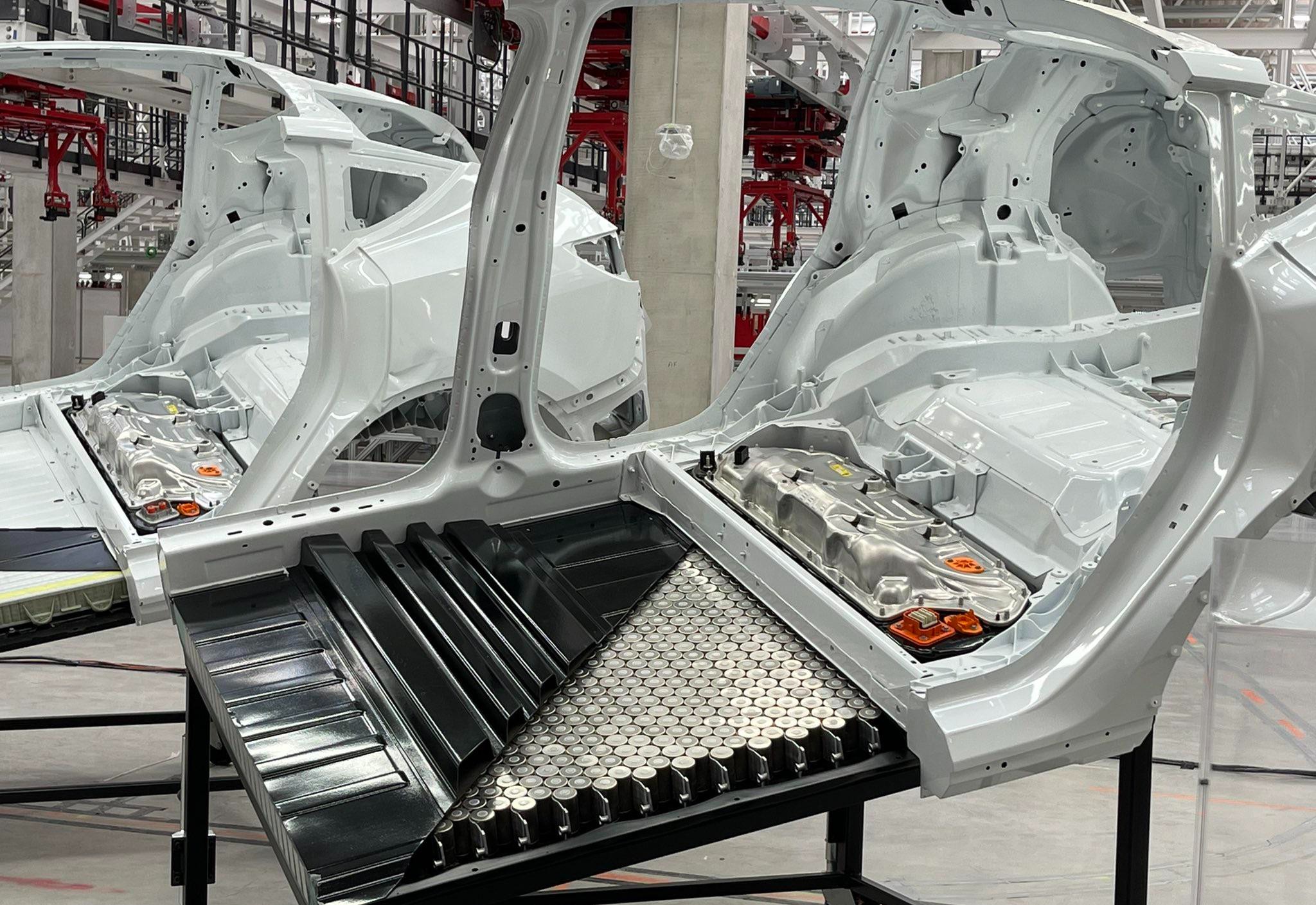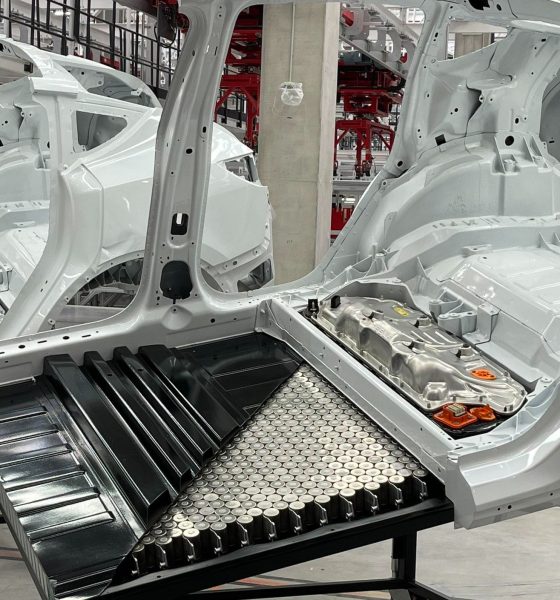

News
Lucid CEO shares thoughts on EV batteries, range, and Tesla’s 4680 battery cells
Lucid CEO Peter Rawlinson recently shared his thoughts about the electric vehicle industry, the battle for range supremacy, and rival Tesla’s efforts to develop and produce its own 4680 cells. According to the CEO, the range of electric vehicles may see some surprising trends in the distant future, and Tesla’s 4680 cells may not be as big of a breakthrough as initially expected.
Rawlinson’s recent comments were shared in an extensive interview with IEEE Spectrum. As a company, Lucid is known to work extremely hard to maximize the range in its vehicles, with the Air sedan, its first car, becoming the first electric vehicle that received an EPA rating above 500 miles per charge. Using the same 2170 cells that are powering vehicles like the Tesla Model 3 and the Rivian R1T, Lucid’s six Air sedan variants have seized the top six spots in the EPA’s range rankings.
The Lucid CEO is not a proponent of simply using more batteries to extend range, similar to what companies like GM are doing with the 350-mile Hummer EV’s 200 kWh battery or what Rivian seems to be doing with the ~400-mile R1T’s 180 kWh pack. As per IEEE, Rawlinson calls such strategies as “dumb range.” This was definitely something that Lucid avoided with the Air sedan, as the vehicle is able to achieve its class-leading 131 MPGe with a 118 kWh battery pack.
Interestingly enough, Rawlinson believes that while there is a battle for range in the electric vehicle sector today, this would likely not be the case in the future. With electric vehicles becoming more commonplace and affordable, and with home charging becoming the norm, the Lucid CEO believes that future electric vehicles may actually have less range. “Fifty or sixty years from now, EVs may actually have less range. Psychologically, there won’t be this sort of paranoia and dependence on a public supercharging network. And home charging is healthier for the battery, anyway,” the Lucid CEO said.
Rawlinson did not seem particularly convinced that some near-term battery breakthroughs are at hand. In the case of Tesla’s 4680 cells, for example, the Lucid CEO noted that he sees potential in the technology. But the upcoming batteries seem more like a triumph of packaging, not of chemistry, with its tightly packed jelly rolls that allow more active cell material vs its surrounding casting. Ultimately, Rawlinson noted that the idea of 4680 batteries being a huge breakthrough is a “fantasy.”
“I do think there’s an upside to going to large format. That would reduce internal resistance, and that’s a valuable step forward. But people are looking at 4680 as this huge breakthrough, and that’s a fantasy,” the Lucid CEO said.
Time would likely prove or disprove Rawlinson’s recent insights on the electric vehicle battery industry. Batteries are only getting better with time, for example, so there may eventually be a point where even extremely affordable electric cars could have range that’s comparable to premium EVs today. Tesla’s 4680 cells could also prove to be a difference-maker in manufacturing, as the cells are specifically designed to lower costs.
Ultimately, the 4680 cells may not necessarily be a silver bullet in the electric vehicle transition, but when they’re coupled with incremental improvements in battery chemistries, dry electrode technologies, structural battery concepts, and the use of megacastings, they could form the backbone for the next generation of mass-market vehicles that may very well take the world by storm. The next few years of Tesla’s growth, which would be represented by the rise of vehicles like the Cybertruck and the Semi, would likely determine just how much potential the 4680 cells really have.
Peter Rawlinson’s full insights from his interview with IEEE Spectrum could be accessed here.
Don’t hesitate to contact us with news tips. Just send a message to tips@teslarati.com to give us a heads up.

Elon Musk
Elon Musk’s X will start using a Tesla-like software update strategy
The initiative seems designed to accelerate updates to the social media platform, while maintaining maximum transparency.

Elon Musk’s social media platform X will adopt a Tesla-esque approach to software updates for its algorithm.
The initiative seems designed to accelerate updates to the social media platform, while maintaining maximum transparency.
X’s updates to its updates
As per Musk in a post on X, the social media company will be making a new algorithm to determine what organic and advertising posts are recommended to users. These updates would then be repeated every four weeks.
“We will make the new 𝕏 algorithm, including all code used to determine what organic and advertising posts are recommended to users, open source in 7 days. This will be repeated every 4 weeks, with comprehensive developer notes, to help you understand what changed,” Musk wrote in his post.
The initiative somewhat mirrors Tesla’s over-the-air update model, where vehicle software is regularly refined and pushed to users with detailed release notes. This should allow users to better understand the details of X’s every update and foster a healthy feedback loop for the social media platform.
xAI and X
X, formerly Twitter, has been acquired by Elon Musk’s artificial intelligence startup, xAI last year. Since then, xAI has seen a rapid rise in valuation. Following the company’s the company’s upsized $20 billion Series E funding round, estimates now suggest that xAI is worth tens about $230 to $235 billion. That’s several times larger than Tesla when Elon Musk received his controversial 2018 CEO Performance Award.
As per xAI, the Series E funding round attracted a diverse group of investors, including Valor Equity Partners, Stepstone Group, Fidelity Management & Research Company, Qatar Investment Authority, MGX, and Baron Capital Group, among others. Strategic partners NVIDIA and Cisco Investments also continued support for building the world’s largest GPU clusters.
News
Tesla FSD Supervised wins MotorTrend’s Best Driver Assistance Award
The decision marks a notable reversal for the publication from prior years, with judges citing major real-world improvements that pushed Tesla’s latest FSD software ahead of every competing ADAS system.

Tesla’s Full Self-Driving (Supervised) system has been named the best driver-assistance technology on the market, earning top honors at the 2026 MotorTrend Best Tech Awards.
The decision marks a notable reversal for the publication from prior years, with judges citing major real-world improvements that pushed Tesla’s latest FSD software ahead of every competing ADAS system. And it wasn’t even close.
MotorTrend reverses course
MotorTrend awarded Tesla FSD (Supervised) its 2026 Best Tech Driver Assistance title after extensive testing of the latest v14 software. The publication acknowledged that it had previously criticized earlier versions of FSD for erratic behavior and near-miss incidents, ultimately favoring rivals such as GM’s Super Cruise in earlier evaluations.
According to MotorTrend, the newest iteration of FSD resolved many of those shortcomings. Testers said v14 showed far smoother behavior in complex urban scenarios, including unprotected left turns, traffic circles, emergency vehicles, and dense city streets. While the system still requires constant driver supervision, judges concluded that no other advanced driver-assistance system currently matches its breadth of capability.
Unlike rival systems that rely on combinations of cameras, radar, lidar, and mapped highways, Tesla’s FSD operates using a camera-only approach and is capable of driving on city streets, rural roads, and freeways. MotorTrend stated that pure utility, the ability to handle nearly all road types, ultimately separated FSD from competitors like Ford BlueCruise, GM Super Cruise, and BMW’s Highway Assistant.
High cost and high capability
MotorTrend also addressed FSD’s pricing, which remains significantly higher than rival systems. Tesla currently charges $8,000 for a one-time purchase or $99 per month for a subscription, compared with far lower upfront and subscription costs from other automakers. The publication noted that the premium is justified given FSD’s unmatched scope and continuous software evolution.
Safety remained a central focus of the evaluation. While testers reported collision-free operation over thousands of miles, they noted ongoing concerns around FSD’s configurable driving modes, including options that allow aggressive driving and speeds beyond posted limits. MotorTrend emphasized that, like all Level 2 systems, FSD still depends on a fully attentive human driver at all times.
Despite those caveats, the publication concluded that Tesla’s rapid software progress fundamentally reshaped the competitive landscape. For drivers seeking the most capable hands-on driver-assistance system available today, MotorTrend concluded Tesla FSD (Supervised) now stands alone at the top.
News
Elon Musk’s Grokipedia surges to 5.6M articles, almost 79% of English Wikipedia
The explosive growth marks a major milestone for the AI-powered online encyclopedia, which was launched by Elon Musk’s xAI just months ago.

Elon Musk’s Grokipedia has grown to an impressive 5,615,201 articles as of today, closing in on 79% of the English Wikipedia’s current total of 7,119,376 articles.
The explosive growth marks a major milestone for the AI-powered online encyclopedia, which was launched by Elon Musk’s xAI just months ago. Needless to say, it would only be a matter of time before Grokipedia exceeds English Wikipedia in sheer volume.
Grokipedia’s rapid growth
xAI’s vision for Grokipedia emphasizes neutrality, while Grok’s reasoning capabilities allow for fast drafting and fact-checking. When Elon Musk announced the initiative in late September 2025, he noted that Grokipedia would be an improvement to Wikipedia because it would be designed to avoid bias.
At the time, Musk noted that Grokipedia “is a necessary step towards the xAI goal of understanding the Universe.”
Grokipedia was launched in late October, and while xAI was careful to list it only as Version 0.1 at the time, the online encyclopedia immediately earned praise. Wikipedia co-founder Larry Sanger highlighted the project’s innovative approach, noting how it leverages AI to fill knowledge gaps and enable rapid updates. Netizens also observed how Grokipedia tends to present articles in a more objective manner compared to Wikipedia, which is edited by humans.
Elon Musk’s ambitious plans
With 5,615,201 total articles, Grokipedia has now grown to almost 79% of English Wikipedia’s article base. This is incredibly quick, though Grokipedia remains text-only for now. xAI, for its part, has now updated the online encyclopedia’s iteration to v0.2.
Elon Musk has shared bold ideas for Grokipedia, including sending a record of the entire knowledge base to space as part of xAI’s mission to preserve and expand human understanding. At some point, Musk stated that Grokipedia will be renamed to Encyclopedia Galactica, and it will be sent to the cosmos.
“When Grokipedia is good enough (long way to go), we will change the name to Encyclopedia Galactica. It will be an open source distillation of all knowledge, including audio, images and video. Join xAI to help build the sci-fi version of the Library of Alexandria!” Musk wrote, adding in a later post that “Copies will be etched in stone and sent to the Moon, Mars and beyond. This time, it will not be lost.”








